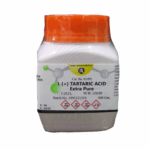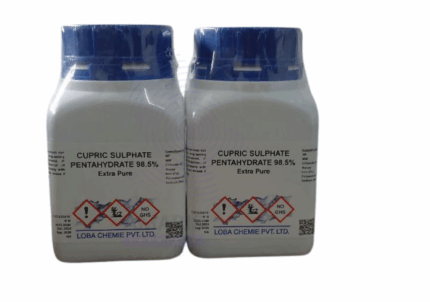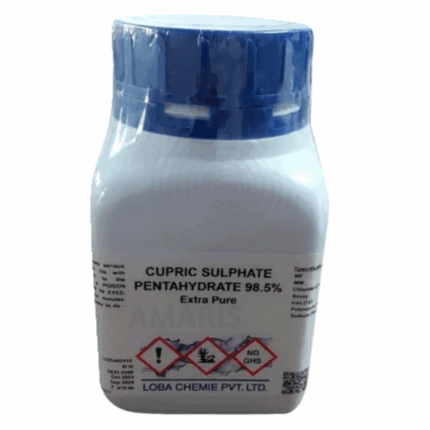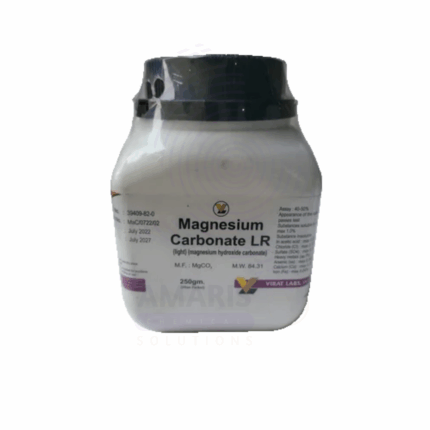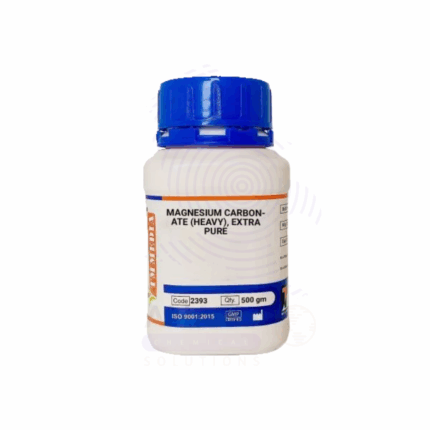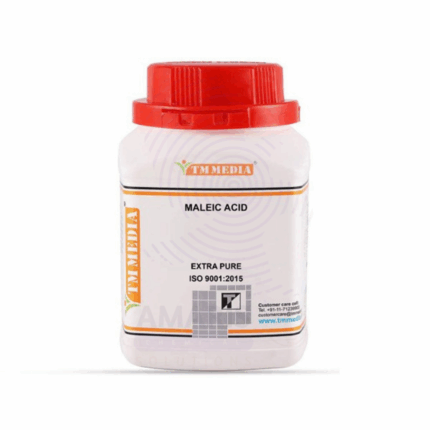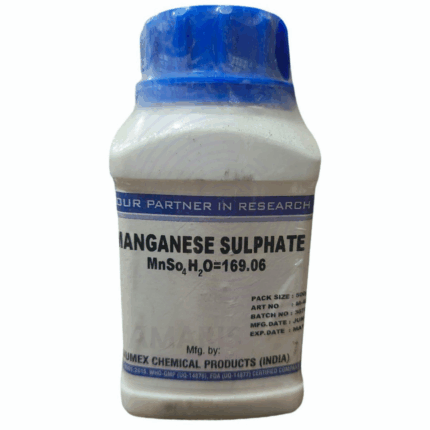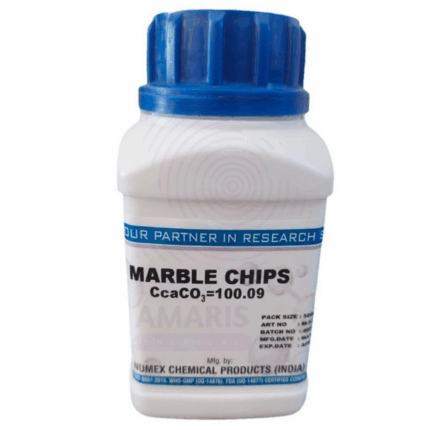
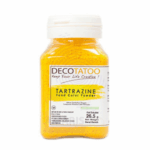
Tartaric Acid Extra Pure
$ 18.20
Tartaric Acid Extra Pure is a white, crystalline, highly water-soluble organic acid widely used in laboratory, pharmaceutical, food, and industrial applications. Known for its stable acidity and chelating properties, it is commonly employed as a reagent in analytical chemistry and as an acidulant in pharmaceuticals and effervescent tablets. In the food and cosmetic sectors, it serves as both a functional ingredient and a natural acid regulator. This Extra Pure grade is ideal for high-precision research and formulation applications requiring consistent quality and purity. It is biodegradable and generally safe when handled with standard precautions.
Tartaric Acid Extra Pure
PRIMARY USES
- Analytical Reagent & Laboratory Applications
- Used as a primary standard for pH calibration and volumetric analysis due to its stable acidic properties
- Employed as a complexing agent in redox titrations and metal ion analysis
- Functions as a buffering agent in biochemical and chemical experiments
- Utilized in preparation of test solutions and calibration standards in analytical labs
- Pharmaceutical & Nutraceutical Industry
- Acts as an acidulant and stabilizer in effervescent tablets, syrups, and oral rehydration solutions
- Incorporated into chewable tablets to improve taste and stability of active pharmaceutical ingredients
- Used in combination with bicarbonates to produce carbon dioxide for tablet disintegration
SECONDARY USES
- Food Industry (in regulated quantities)
- Serves as a flavor enhancer and acidity regulator (E334) in beverages, jellies, candies, and baking powders
- Acts as a chelating agent for metal ions, improving product stability
- Used to control crystallization in sugar-based products
- Cosmetic and Personal Care Industry
- Used in skin exfoliation and brightening products for its alpha-hydroxy acid (AHA) properties
- Functions as a pH adjuster and antioxidant stabilizer in creams and lotions
- Textile and Dyeing Industry
- Used in dyeing processes to maintain pH and improve color fixation
- Acts as a chelating and dispersing agent in textile treatments
1. Basic Identification Attributes
- Chemical Name: Tartaric Acid
- CAS Number: 87-69-4
- HS Code: 2918.12.00
- Molecular Formula: C₄H₆O₆
- Synonyms: L-(+)-Tartaric acid, 2,3-Dihydroxybutanedioic acid, E334
2. Physical & Chemical Properties
- Physical State: Crystalline solid or powder
- Color & Odor: White, odorless
- Melting Point: 171–174 °C (decomposes)
- Solubility: Highly soluble in water (~139 g/L at 20 °C), slightly soluble in ethanol
- pH Level: Strongly acidic (pH ~2.2 for 1% solution)
- Stability: Stable under dry, cool conditions
- Optical Activity: Naturally occurring L(+)-isomer is optically active
3. Safety & Hazard Attributes
- Hazard Class (GHS Classification): Eye irritation (Category 2A), Skin irritation (Category 2)
- NFPA Ratings: Health 1, Flammability 0, Reactivity 0
- Exposure Limits: Not classified under OSHA or ACGIH with specific exposure limits
- Reactivity: Stable under normal conditions; reacts with strong oxidizers and bases
4. Storage & Handling Attributes
- Storage Conditions: Store in a tightly sealed container in a cool, dry, well-ventilated area
- Incompatible Materials: Strong oxidizing agents, strong bases
- Container Type: Plastic or glass jars with secure closure
- Shelf Life & Expiration Date: Stable for several years if properly stored
- Special Handling Requirements: Avoid inhalation and contact with skin or eyes; use PPE
5. Regulatory & Compliance Attributes
- Regulatory Status: Approved as a food additive (E334), listed in pharmacopeias (USP, BP, FCC)
- Transportation Restrictions: Not classified as hazardous for transportation
- Waste Disposal Method: Dispose in accordance with local environmental regulations
6. Environmental & Health Impact
- Ecotoxicity: Low aquatic toxicity at typical use concentrations
- Persistence in Environment: Biodegradable under aerobic conditions
- Carcinogenicity/Mutagenicity: Not classified as carcinogenic or mutagenic
- Biodegradability: Readily biodegradable
SAFETY PRECAUTIONS
Personal Protective Equipment (PPE):
- Wear chemical-resistant gloves
- Use safety goggles or face shield
- Wear lab coat or apron
- Use a dust mask or respirator if powder is airborne
Handling:
- Handle in a well-ventilated area
- Avoid contact with eyes, skin, and clothing
- Avoid inhalation of dust
- Wash thoroughly after handling
Storage:
- Keep container tightly closed
- Store in a dry, cool, and well-ventilated area
- Protect from moisture and incompatible substances
FIRST AID MEASURES
Inhalation:
- Move to fresh air
- Seek medical attention if symptoms occur
Skin Contact:
- Wash with soap and water
- Remove contaminated clothing
- Seek medical attention if irritation persists
Eye Contact:
- Rinse with water for at least 15 minutes
- Seek medical attention promptly
Ingestion:
- Rinse mouth with water
- Do not induce vomiting
- Seek medical attention if symptoms appear
FIRE FIGHTING MEASURES
Flammability:
- Not flammable under normal conditions
Extinguishing Media:
- Use water spray, foam, dry chemical, or CO₂
Hazardous Combustion Products:
- May release carbon monoxide and carbon dioxide upon combustion
Firefighter Protection:
- Wear self-contained breathing apparatus (SCBA) and protective clothing
- Avoid inhalation of thermal decomposition products


 Preservatives(food)
Preservatives(food) Flavor Enhancers
Flavor Enhancers Acidulants
Acidulants Sweeteners
Sweeteners Antioxidants
Antioxidants Colorants(food)
Colorants(food) Nutraceutical Ingredients (food)
Nutraceutical Ingredients (food) Nutrient Supplements
Nutrient Supplements Emulsifiers
Emulsifiers
 Collectors
Collectors Dust Suppressants
Dust Suppressants Explosives and Blasting Agents
Explosives and Blasting Agents Flocculants and Coagulants
Flocculants and Coagulants Frothers
Frothers Leaching Agents
Leaching Agents pH Modifiers
pH Modifiers Precious Metal Extraction Agents
Precious Metal Extraction Agents
 Antioxidants(plastic)
Antioxidants(plastic) Colorants (Pigments, Dyes)
Colorants (Pigments, Dyes) Fillers and Reinforcements
Fillers and Reinforcements Flame Retardants
Flame Retardants Monomers
Monomers Plasticizers
Plasticizers Polymerization Initiators
Polymerization Initiators Stabilizers (UV, Heat)
Stabilizers (UV, Heat)
 Antifoaming Agents
Antifoaming Agents Chelating Agents
Chelating Agents Coagulants and Flocculants
Coagulants and Flocculants Corrosion Inhibitors
Corrosion Inhibitors Disinfectants and Biocides
Disinfectants and Biocides Oxidizing Agents
Oxidizing Agents pH Adjusters
pH Adjusters Scale Inhibitors( water)
Scale Inhibitors( water)
 Antioxidants(cosmetic)
Antioxidants(cosmetic) Emollients
Emollients Fragrances and Essential Oils
Fragrances and Essential Oils Humectants
Humectants Preservatives
Preservatives Surfactants(cosmetic)
Surfactants(cosmetic) Thickeners
Thickeners UV Filters
UV Filters
 Fertilizers
Fertilizers Soil Conditioners
Soil Conditioners Plant Growth Regulators
Plant Growth Regulators Animal Feed Additives
Animal Feed Additives Biostimulants
Biostimulants Pesticides (Herbicides, Insecticides, Fungicides)
Pesticides (Herbicides, Insecticides, Fungicides)
 Active Pharmaceutical Ingredients (APIs)
Active Pharmaceutical Ingredients (APIs) Excipients
Excipients Solvents(pharmaceutical)
Solvents(pharmaceutical) Antibiotics
Antibiotics Antiseptics and Disinfectants
Antiseptics and Disinfectants Vaccine Adjuvants
Vaccine Adjuvants Nutraceutical Ingredients (pharmaceutical)
Nutraceutical Ingredients (pharmaceutical) Analgesics & Antipyretics
Analgesics & Antipyretics
 Analytical Reagents
Analytical Reagents Solvents(lab)
Solvents(lab) Chromatography Chemicals
Chromatography Chemicals Spectroscopy Reagents
Spectroscopy Reagents microbiology-and-cell-culture-reagents
microbiology-and-cell-culture-reagents Molecular Biology Reagents
Molecular Biology Reagents Biochemical Reagents
Biochemical Reagents Inorganic and Organic Standards
Inorganic and Organic Standards Laboratory Safety Chemicals
Laboratory Safety Chemicals Specialty Laboratory Chemicals(Special Laboratory Equipment)
Specialty Laboratory Chemicals(Special Laboratory Equipment)
 Demulsifiers
Demulsifiers Hydraulic Fracturing Fluids
Hydraulic Fracturing Fluids Scale Inhibitors(oil)
Scale Inhibitors(oil) Surfactants(oil)
Surfactants(oil) Drilling Fluids
Drilling Fluids
 Dyes and Pigments
Dyes and Pigments Bleaching Agents
Bleaching Agents Softening Agents
Softening Agents Finishing Agents
Finishing Agents Antistatic Agents
Antistatic Agents
 Admixtures
Admixtures Waterproofing Agents
Waterproofing Agents Sealants and Adhesives
Sealants and Adhesives Curing Compounds
Curing Compounds Concrete Repair Chemicals
Concrete Repair Chemicals Anti-Corrosion Coatings
Anti-Corrosion Coatings
 Surfactants(cleaning)
Surfactants(cleaning) Builders
Builders Enzymes
Enzymes Solvents (Cleaning)
Solvents (Cleaning) Fragrances
Fragrances
 Electronic Chemicals
Electronic Chemicals Catalysts
Catalysts Lubricants
Lubricants Photographic Chemicals
Photographic Chemicals Refrigerants
Refrigerants Automotive chemicals
Automotive chemicals Pyrotechnic Chemicals
Pyrotechnic Chemicals
 Biodegradable Surfactants
Biodegradable Surfactants Bio-based Solvents
Bio-based Solvents Renewable Polymers
Renewable Polymers Carbon Capture Chemicals
Carbon Capture Chemicals Wastewater Treatment Chemicals
Wastewater Treatment Chemicals
 Pigments
Pigments Solvents(paint)
Solvents(paint) Specialty Coatings
Specialty Coatings Binders/Resins
Binders/Resins Additives
Additives Driers
Driers Anti-Corrosion Agents
Anti-Corrosion Agents Functional Coatings
Functional Coatings Application-Specific Coatings
Application-Specific Coatings
 Fresh Herbs
Fresh Herbs Ground Spices
Ground Spices Whole Spices
Whole Spices Spice Blends
Spice Blends Dried Herbs
Dried Herbs
 Leavening Agents
Leavening Agents Dough Conditioners
Dough Conditioners Flour Treatments
Flour Treatments Fat Replacers
Fat Replacers Decoratives
Decoratives Preservatives(baking)
Preservatives(baking)
 Plasticizers & Softeners
Plasticizers & Softeners Reinforcing Agents
Reinforcing Agents Adhesion Promoters
Adhesion Promoters Vulcanizing Agents
Vulcanizing Agents Antidegradants
Antidegradants Blowing Agents
Blowing Agents Fillers & Extenders
Fillers & Extenders Accelerators & Retarders
Accelerators & Retarders

